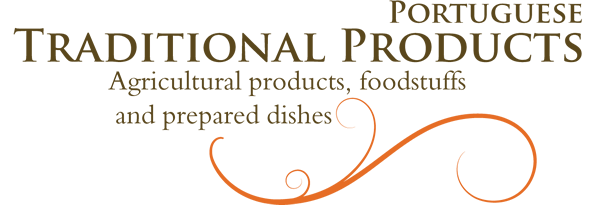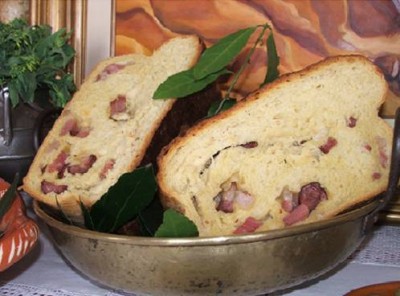Description: rectangular bakery product made from wheat bread dough, eggs, PDO Trás-os-Montes extra-virgin olive oil (or olive oil with similar organoleptic characteristics), vegetable margarine and/or pork lard, filled with fatty pig meat and/or dry and salty streaky bacon (not smoked), dry and salty pork belly (not smoked), smoke-cured pork sausages (salpicão and linguiça), smoke-cured or dry-cured ham and/or smoked pork shoulder.
Production method: The production method include the following phases: preparation and mixing of the bread dough, rising, filling, pre-freezing (optional), baking and packaging (optional).
Special features: The Folar de Valpaços PGI can be distinguished from other similar products by the way the bread dough is prepared, using two fermentation phases specific to the Valpaços municipality.
Also the olive oil used is PDO Trás-os-Montes extra-virgin olive oil (or olive oil with similar organoleptic characteristics), whose specific flavours and aromas are transferred to the bread dough and consequently to the final product. The distinctly fruity flavour of the dough owes itself to the flavour and smell of fresh fruit and sweet, green, bitter and spicy sensation of the olive oil used.
Production area: Defined to the municipality of Valpaços.
History: The link between Folar de Valpaços PGI and the geographical area is based on reputation. The word “folar” is often associated with a present and/or gift and means “the best”. Traditionally, the “folar” was made at Eastertime. On Easter Sunday, in what was called the “Compasso” or Easter visit, the clergy collected the “folar” from the families.
The first reference to the recipe with the name “Folar de Valpaços” was in 1959 in the cookbook “Livro de Pantagruel” (Pantagruel’s Book) (Bertha Rosa Limpo, 1959). Afterwards it appeared in various works on national cuisine, notably in the book “Cozinha Tradicional Portuguesa” (Traditional Portuguese Cuisine) by Maria de Lourdes Modesto (1982). Virgílio Nogueiro Gomes noted the reputation and use of the name “Folar de Valpaços” in his book “Transmontanices – Causas de Comer” (Transmonticisms — Reasons to Eat) (2010) and in his chronicles “Folares e a Páscoa” (Folares and Easter) (2009) and “Cadernos de Receitas” (Recipe Books) (2012).
Product specification (pdf)
Producer group
Cooperativa Agrícola de Valpaços, C. R. L. – COOPAÇOS
Control and certification body
Kiwa Sativa – Unipessoal, Lda.
Control plan
Control plan (pdf)
Publicações no Jornal Oficial da UE
Regulamento de Execução (UE) 2017/249 da Comissão, de 1.02.2017
Documento Único, de 18.10.2016
Publication in the Portuguese official journal
Aviso (extrato) n.º 4617/2016, de 6 de abril
Aviso n.º 8685/2015, de 28 de julho



